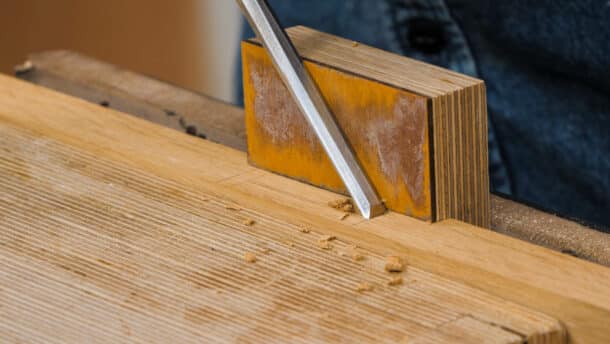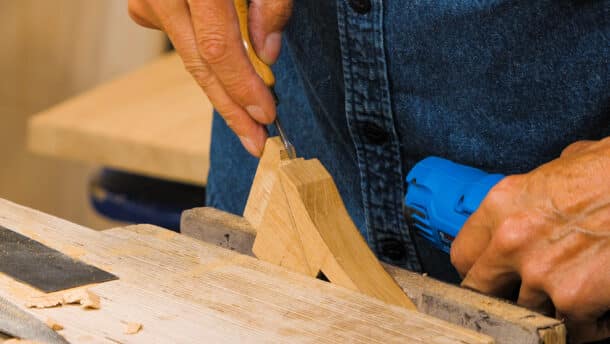Floor Lamp
Posted 18 August 2020
This is the introductory page for a paid video series. Want to watch more of this project? Select the best option below to get started.
When a design just comes together in your head, and you then make it exactly to the plan you formulated while riding your bike, it is truly satisfying. This is one of those projects. Different joinery than you’ve seen before, and the complex appearance is total simplicity. Join Paul on this one and you will not regret it!






Absolutely fantastic. There have been some great projects recently in WWM and this looks like it could be one of the best yet.
Wow paul…I need this one! Could The circular shelf Be laminated or do you recommend one piece? Also could it have a contrasting colour to highlight the joinery?
That’s what I needed for a long time. No excuse for not building it now. Thanks Paul.
My wife caught sight of this project – guess what I’m making next!
It is lovely and I look forward to getting started on it.
Thank you Paul.
Very, very nice.
Beautiful! I’m anxious to build this one!
Paul, this is an extremely nice looking piece. The proportions look perfect. I can already see myself sitting next to this lamp reading one of my favourite books written by Paul Sellers!
Looks nice, interested to see how the circles are made, its something i’ve struggled with in the past.
Great choice of project for us Paul; looking forward to this…
Lovely chair too by the way… pity that’s not on the list… I do like a bit of upholstering. I attached leather padded panels to the head and foot of a doulble bed I made back in 2008. Really pleased with the first-time results too.
Thanks all for all your your dedication; but of course, it’s a vocation not ‘work’… 🙂
Interesting choice of wording…you had a “lightbulb moment” when you chose to design a lamp.
Does make you wonder what LED to such creative wordsmithing.
Does anyone have the cut list, or know the length of the arms that have the tenons cut in them? Got everything cut but the arm lengths, so I’m kind of stuck. Maybe I missed it in the video content?
As of this date and time the site states that the cut-list and drawings will follow – generally these turn up as a PDF half-way through the project.
The geometry of dividing the circular plate-bracket could have been explained a bit clearer, but the dimensions will, no doubt, be shown in the plans. Even so, repeating the video a few times at that point makes it clear.
Even so, as with most of the items that feature here as projects, you can prune these back to an idea and scale the sizes of yours up or down, work out angles that suit you and so on. Many of these projects can be altered.
You don’t need to make an exact copy…….. unless you want to, of course!
Thanks for the reply.
I used the video to come up with real and approximate sizes, but now I’ve started to draw a template of my own to see if I can come up with reasonable angles and sizes for the rest of the pieces. It’s a good exercise regardless.
I didn’t realize the drawings usually show up middle of the project. Makes it a little challenging to follow along weekly, but I understand these things take time. I’m pretty sure Paul’s team are a bit short-staffed due to current circumstances.
Hello, Rod. I guess that as Paul does all his own drawings, plus the added complications of lone-working these days, he’s got a good reason. But the PDfs usually post mid-way through the exercise, so it’s worth being patient. The up-side is that it challenges us to solve our own issues.
He says that he came up with the idea riding his bike through Abingdon one day…… then probably spent a good while longer working out the details!
The best way to establish angles is to lean a few lengths of wood together, stand back and adjust the stand-and-lean until you get an angle that pleases you – simply put, if it looks right, then it is right.
If you don’t have a full sized piece of ply to use as a template, I’ve used thick backing-wall-paper the size and shape of which will suit this lamp project. You can then lay out the angles, top and bottom, measuring the stock from that.
Apart from the techniques Paul’s showing is the emphasis on ‘live thinking’ as we work and solving issues as they arise.
Good luck with it.
Angle of the tenon shoulder is missing from the drawing????
Hi,
Paul says:
5.1 degrees, we avoided giving the angle in the drawing because any variation in distance will affect that angle.
Kind Regards,
Izzy
I calculated 5 degrees and it seems to work fine for me. The top and bottom angles clamp together quite nicely.
The drawing lacks some details like how much of the spokes are inset into the circles etc. The video shows that Paul inserts 2 3/4″ of the spoke into the bottom circle. For the top, 2″ to 2 1/4″ looks okay, from which I estimate the angle as that of a triangle with base 42 1/4″ and side 3 3/4″ (about 5.1 degrees). Better use your own dimensions and then estimate the angle from a drawing or otherwise.
The uprights are long, can flex a bit and accommodate some error in the angle still keeping the shoulders tight.
Just finished this really elegant project. Thank you Paul. Improvised a little with the table brackets and just used single curved pieces as I wasn’t keen on adding the “Uplift Blocks”, otherwise followed the designed to the letter. Left the Mrs to chose a really cool 50cm lampshade!
Can you confirm the measurement from the bottom of the leg to the underside of the first mortice hole. In the video it’s given as 6 1/2″ but the drawing shows it as 6 1/4″. Not sure it makes all that much difference, but Paul does make a point of saying the measurement is important.
Many thanks.
I made this lamp a few months ago and love the way it looks. Beautiful design and, in spite of the complex geometry, it came out very nicely. I used black walnut for the upper and lower discs that hold it all together, and that added a nice contrast; got a handsome custom lampshade from a small company in Wisconsin. By the way I used 85 degrees for the angled cuts.
So, I decided to make another one (and correct a couple of measurements that I had mistakenly altered). This time the joinery did not come out clean; some of the tenon shoulders aren’t lining up. When I put it together for the first time this afternoon I got the bad news. Since the piece didn’t go together easily, that’s where I’ll need to start troubleshooting. If I figure it out, I’ll post again; hopefully it won’t become kindling for the stove.
I made this project over the last couple of weeks and thoroughly enjoyed it. The angles for the tenon shoulders can be an issue. For the metric measurements I suspect (no maths done) 6° off plumb is closer. At first assembly I found the top of the tenon shoulders gappy by an equal amount on all joints top and bottom. But rather than try to correct the shoulders I decided to recess the edge of the dados on the top round by a tiny amount (about 1mm) (since that becomes a hidden joint) – this pulled things together nicely.
Hello friends,
Need an advise: will 3/4″ oak will be good enough for this project?
Thanks!